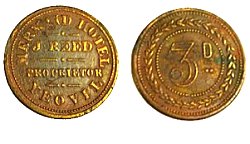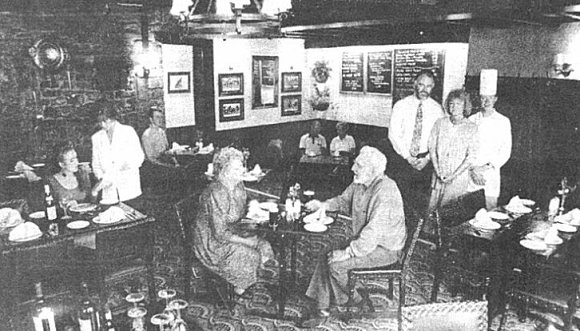the history of yeovil's pubs
PUBS HOME PAGE |
PUBS INTRODUCTION |
PUBS BY NAME |
BEERHOUSES |
mermaid hotel
2 High Street
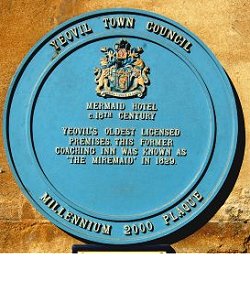 The
oldest surviving
licensed
premises in
Yeovil (until it
permanently
closed in 2019), marked
'A' on the 1886
map below,
despite an
overabundance of
competition,
with the
earliest mention
in the records
being 1517. It
was recorded in
1629 as the Miremaide
although many
people
(including the
Town Council -
see photo at
left) tend to
read too much
into this
spelling form
while forgetting
that before the
introduction of
the Board
Schools in the
1870s there was
no standardised
system of
spelling in the
English language
- even
Shakespeare
spelt his own
name four
different ways!
The
oldest surviving
licensed
premises in
Yeovil (until it
permanently
closed in 2019), marked
'A' on the 1886
map below,
despite an
overabundance of
competition,
with the
earliest mention
in the records
being 1517. It
was recorded in
1629 as the Miremaide
although many
people
(including the
Town Council -
see photo at
left) tend to
read too much
into this
spelling form
while forgetting
that before the
introduction of
the Board
Schools in the
1870s there was
no standardised
system of
spelling in the
English language
- even
Shakespeare
spelt his own
name four
different ways!
In 1618 an order was made that only nine licensed premises be allowed in the borough (that is the town, not that part of High Street today called the Borough) and two outside, with the rest being 'suppressed'. The Mermaid was undoubtedly one of the nine 'allowed' premises.
Originally, of course, the Mermaid was much smaller than it is today, being only that part from the arch and to the east; that part now 1a and 1b High Street to the west of the arch was originally built as a single town house in the late eighteenth century.
Having said that, I have recently discovered a notice, reproduced below, in the Salisbury & Winchester Journal of 13 November 1769 when Samuel Lloyd took over the establishment from George Gast that states ".... the whole House (except two Rooms in Front) with the Assembly Room, Stables, and all other Offices, have been built from the Ground by Mr Gast within these ten Years..."

Salisbury &
Winchester
Journal, 13
November 1769
George Gast died in 1769. For his will, click here.
The Mermaid was often used as a meeting place for societies and other groups - for example in 1817 the Mermaid was the venue for the first performance by the Yeovil Philharmonic Society (I wonder whatever happened to them?) before an audience of 150.
 Always an
important
coaching inn, in
the early 1850's
the 'Telegraph'
stagecoach left
from the Mermaid
Hotel at 7:30am
every day, bound
for Salisbury
where travellers
could then catch
the train to
London. Also the
Mermaid had its
own horse-drawn
omnibuses, as
seen in the
photograph at
left of about
1907. These were
used to
transport guests
between the
hotel and the
various railway
stations -
Hendford Halt,
Yeovil Town
station, Pen
Mill station and
Yeovil Junction
- meeting every
passenger train.
A similar
service was
carried out by
the Three
Choughs Hotel.
Always an
important
coaching inn, in
the early 1850's
the 'Telegraph'
stagecoach left
from the Mermaid
Hotel at 7:30am
every day, bound
for Salisbury
where travellers
could then catch
the train to
London. Also the
Mermaid had its
own horse-drawn
omnibuses, as
seen in the
photograph at
left of about
1907. These were
used to
transport guests
between the
hotel and the
various railway
stations -
Hendford Halt,
Yeovil Town
station, Pen
Mill station and
Yeovil Junction
- meeting every
passenger train.
A similar
service was
carried out by
the Three
Choughs Hotel.
These buses were also available for hire in the evenings, especially for the dances and parties held at Christmas time. Both hotels had waggonettes of different sizes - the largest big enough to take cricket or football teams - which could be hired at short notice.
An article from the Daily Herald, dated 25 January 1949, recounts the origin of the inn's name "Ever since 1571 The Mermaid Hotel - an old coaching inn - has been putting up travellers. Round the walls and from the low ceilings hang reminders of the days when the Quicksilver Royal Mail coach stopped at Yeovil. But in its long history The Mermaid, which has no connection with the sea, but gets its name from the Maid of Mere..."
None of the very early licensees except one are known and this exception appears on a trade token. Most Yeovil trade tokens (as opposed to public house 'checks' - see below) were issued by tradesmen following the death of Charles I in 1649 in order to overcome the lack of small change in general circulation. No copper coinage was minted during the Commonwealth and the resulting paucity of small coinage was met by these independently-produced and completely unauthorised tokens of brass or latten (copper alloys similar to brass). In 1672 farthings were minted in the reign of Charles II with the consequent demise of trade tokens.
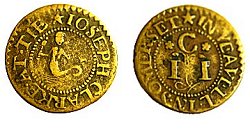 At left is a
farthing trade
token, much
magnified the
original being
some 15mm in
diameter, from
the Mermaid,
undated but
falling within
the period 1649
to 1672.
At left is a
farthing trade
token, much
magnified the
original being
some 15mm in
diameter, from
the Mermaid,
undated but
falling within
the period 1649
to 1672.
It is inscribed on the obverse "IOSEPH (Joseph) CLARKE AT THE (a Mermaid)". On the reverse is inscribed "IN YEAVELL IN SOMERSET - C.I.I."'. Tokens usually had three initials, representing the two Christian names of the issuer and his wife plus their surname.
|
|
At left is a later public house 'check' from my collection which is easily dated since it was issued by John Reed when he was proprietor of the Mermaid Hotel and he was only recorded there in 1897. On the obverse is "MERMAID HOTEL" over "J REED" over "PROPRIETOR" over "YEOVIL", the reverse has the standard closed wreath containing the value 2d. Made of bronze or brass, it is just under 28mm in diameter and is 1.2mm thick. The lower example is different only in its value - 3d. At this time three old pence could buy you a good feed of tripe and onions. |
Checks were frequently used in games, such as skittles or quoits where, for instance, players would 'chip in' a check to the 'kitty' which would be won by the winning team to redeem at the bar. By issuing checks a landlord could guarantee they would be spent in his establishment only.
See also Yeovil Trade Tokens and Checks
In the Yeovil Guide of 1962 the Manor Hotel and the Mermaid Hotel were the most expensive hotels in Yeovil with Bed and Breakfast from 25/- per night (about £48 at today's value). For comparison the Three Choughs Hotel was 22/6 per night, the Pen Mill Hotel was 16/-, the Elephant & Castle Hotel was 15/6 and the Globe & Crown was cheapest at 14/6 (about £13.50 at today's value). By 1970 the prices were still the most expensive at the Manor Hotel with Bed & Breakfast from 45/- to 55/- per night (£50 to £63 at today's value), lunch at 14/6 (about £19) and dinner at 16/6 (about £22). Again for comparison, Bed & Breakfast at the Three Choughs Hotel was 42/- per night with breakfast only at 9/6 and tea from 3/6, the Preston Hotel was from 32/6 per night with lunch at 12/6 and dinner from 14/6, the Butchers Arms was 25/- for a single and 45/- for a double room per night and the Elephant & Castle Hotel was cheapest at 21/6 (about £29) per night.
 Pevsner in "The
Buildings of
England - South
and West
Somerset"
describes the
Mermaid as "an
entertaining Gothick version
of the classical
theme of the inn
archway with a
Venetian window
above. The
archway has
couple shafts
and a trefoiled
head, and the
Venetian window
has - is this
unique? -
ogee-headed
sides and a
pointed-trefoiled
centre".
Pevsner in "The
Buildings of
England - South
and West
Somerset"
describes the
Mermaid as "an
entertaining Gothick version
of the classical
theme of the inn
archway with a
Venetian window
above. The
archway has
couple shafts
and a trefoiled
head, and the
Venetian window
has - is this
unique? -
ogee-headed
sides and a
pointed-trefoiled
centre".
Well it may have been unique when Pevsner saw it in the late 1950's, and it may be unique now - but originally there was a building, now demolished and replaced, on the corner of High Street and Princes Street with a matching window.
In 1879 the Town Council minutes of 2 September noted that "Complaints made that the drain from the 'Mermaid Hotel' had not been commenced; the Surveyor stated that it would be open next week."
In October 1886 the Mermaid Hotel was sold by retiring John Corrie and reported in the Western Gazette as ".... that valuable and well known old-established hostelry, the property of Mr John Corrie, who has carried on a most successful business there for the past 25 years." The hotel was sold for £4,950 (around £480,000 at today's value).
|
"A
fire,
which at
one time
threatened
to be of
a very
serious
character,
broke
out on
Monday
night at
the rear
of the
Mermaid
Hotel.
No time
was lost
in
attaching
the hose
to the
hydrants
in the
streets,
and a
copious
supply
of water
being
poured
upon the
flames,
extinguished
them
before
much
damage
was
done.
There
was
great
excitement
in the
town,
there
being
many old
business
premises
adjacent.
It was
not
generally
known
that a
quantity
of
paraffin
and
other
oils was
stored
near,
belonging
to
tradesmen
in the
Borough,
or the
anxiety
experienced
by those
who
resided
in the
Borough
would
have
been
greatly
intensified.
The
horses
which
were in
the
stable
for the
night
were
rescued
with
difficulty.
What
would
otherwise
have
proved
to be a
most
disastrous
fire was
subdued
in half
an hour
after
the
outbreak
by the
prompt
action
of the
fire
brigade
and
others." |
The following description is taken from the Somerset Historic Environment Record -
"Inn, with shop; both known to have existed by 1770. Ham stone ashlar with stone slated roof between coped gables with brick chimney stacks (renewals) at each end. Apparently built at the same time as Nos 1A and 1B. Wide opening on left-hand side with bolection moulded round trefoil arch with moulded imposts and return of moulding down jambs as Quasi-columns onto a simple plinth. The old gate survives. To the right a C20 shopfront. Above the arch a triple window with plain surround and impost blocks - the centre 9-pane sash has a round trefoil arched head with non-radial toplight and the side 6-pane sashes have depressed ogee arches: to the right two 8-pane sashes in simple architraves; above a cornice with hidden gutters behind. Inside the archway a porch with traces of brick nogging to a timber stud partition. The interior much altered at both floor levels, but some original doors and panelling remain, and the cellars not greatly changed. There are early C20 extensions to the rear yard, which has a separate entrance to Princes Street. Note the plates proclaiming "Member of the Licensed Victuallers Defence League of England and Wales" on both entrance gates. (Mortgage deed of 1770 in frame just inside main entrance)."
|
Yeovilians remember... From me - "Because of its proximity to the animal market it enjoyed special traditional market day opening hours that meant that farmers and dealers attending the market could get a 'wet' breakfast at something like seven in the morning. The Mermaid was one of several pubs in Yeovil that were allowed special market day opening hours on Fridays, basically staying open all day at a time when most pubs only opened for three hours at lunchtime and then closed for the afternoon, opening again later for the evening session. More than once I've taken a half-day's leave from the office and had a 'market day afternoon' which, at the time, was a rare treat now almost forgotten with today's relaxed 'open all day' licensing laws. During the mid to late 1970's I was in here nearly every lunchtime anyway as, at that time, I worked in the Council offices across the road and our back door was, fortuitously, directly opposite the 'Merm'." |
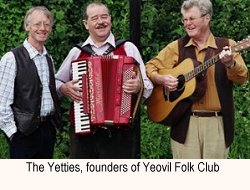 Prior
to
turning
professional,
the
Yetties
set up
the
Yeovil
Folk
Club
in 1963,
initially
at the
Mermaid
Hotel
but
later
moving
to the
Half
Moon. They
booked
people
from all
over the
place,
including
Julie
Felix. Paul
Simon sang
there in
1965, on
an early
pre-Garfunkel
tour.
“We gave
him ten
quid
because
he was
so good”
remembers
Bonny
Sartin
of the
Yetties.
Prior
to
turning
professional,
the
Yetties
set up
the
Yeovil
Folk
Club
in 1963,
initially
at the
Mermaid
Hotel
but
later
moving
to the
Half
Moon. They
booked
people
from all
over the
place,
including
Julie
Felix. Paul
Simon sang
there in
1965, on
an early
pre-Garfunkel
tour.
“We gave
him ten
quid
because
he was
so good”
remembers
Bonny
Sartin
of the
Yetties.
The following is from an article in the Western Gazette of 13 July 1990 -
|
Mermaid pub is saved The Mermaid Hotel, Yeovil, which closed a few days ago after the sudden departure of the licensees, can reopen. An emergency application for a protection order for the hotel was granted by Yeovil magistrates on Tuesday. This will enable Mr Ian Butters of Bywell Avenue, South Shields, to take over as relief manager. Mr Gareth Isaac, for Bass South West Ltd, who own the hotel, said the joint licensees had indicated that they were not prepared to carry on. Mr Robert Felstead, the local Bass manager, said Mr Butters had been employed as a relief manager for the past two years and his appointment at the Mermaid might be made permanent if he made a success of the job. |
The following is
from an article
in the Yeovil
Express of 30
September 1993
(clearly, Ian
Butters didn't
work out) -
|
Moving in at the Mermaid The historic 17th (sic) century coaching inn, the Mermaid Hotel, in Yeovil's High Street was recently taken over by JC & RH Palmer of Bridport from Bass Taverns. John McClimonds is the new tenant with landlady June Dearnley. John has been with Palmers for eight years. Head chef Clive, who is London-trained, moved to the Mermaid from Bridport with John and June and is now accompanied by the second chef, Garry. The Mermaid is steeped in historical interest and is believed to have once accommodated the infamous Judge Jefferies and his notorious Bloody Assizes [Bob's Note - completely untrue]. Watch out, it is also purported to have several unpaying 'spirits'.
The restaurant at the Mermaid Hotel, 1993 - with John McClimonds, June Dearnley and head chef Clive at right. |
![]()
The first of the 'modern' licensees appearing in the records was Frederick Watts. He was born in Frome around 1804 and he is first recorded as licensee of the Mermaid when he became the new landlord of the Mermaid in November 1838 and celebrated, as reported in the Salisbury & Winchester Journal of 19 November, with a celebratory dinner ".... when upwards of 100 persons sat down to one of the most sumptuous entertainments.... the courses consisted of soups, fish, game, made-dishes, poultry, select joints of meat, and all the vegetables in and out of season, served up in upwards of 500 dishes."
He was listed in Robson's Directory of 1839 and makes his final appearance twenty years later in the Harrison, Harrod & Co's 1859 Directory. For whatever reason Frederick was not present on the night of the 1841 census, so his wife, Sarah, is listed in the census as the inn keeper. The 1851 census listed him as the hotel keeper alongside his wife, Sarah, their daughter and a niece. Living in at the time were also a coachman, chambermaid, waitress, cook, under ostler, boots, post-boy and barmaid but, strangely, no guests were listed in the hotel. Frederick Watts died in June 1855, despite which he was still being listed in trade directories in 1859.
The next licensee, John Corrie, was born in Dumfries, Scotland about 1826. He was the son of blacksmith Ephriam Corrie and his wife, Mary and in 1841, at the age of 12, John was an apprentice tailor. In 1854 he married Elizabeth Cordwent at Wellington, Somerset and by the 1861 census they were living in the Mermaid Hotel, where John was listed as hotel keeper, with their young daughter, Bessie. (Son Robert and another daughter, Mary, were absent on the night of the census). At the Petty Sessions in August 1864 John was fined for ".... having in his house three cups purporting to be pints." They had been measured by the police and each was found to be a gill short, to which John responded that they were not used as pints, but as three-penny tankards for ale, stout, etc, whereas the cost of a pint was fourpence. Despite his protestations, he was fined 20s and costs. Two more children, Kate and William, were born during the 1870's. John, Elizabeth and daughter Mary were still living in the Mermaid in 1881 and John's final listing in a trade directory was the following year. John retired in 1888 and by the time of the 1891 census John, listed as a retired hotel proprietor, was living in Preston Road (at Grove House) with Elizabeth, son Robert, daughter Kate and a female servant. John died in September 1898.
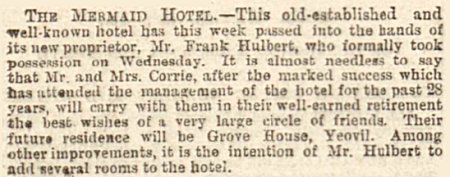
From the 22 June 1888 edition of the Western Gazette in which it was noted that John Corrie and his wife were retiring to live at Grove House and Frank Hulbert was taking over the Mermaid.
Frank Hulbert's
early life is
something of a
mystery, he was
born in Stoke
Newington,
Middlesex (now
Greater London)
about 1865 but
his parents are
unknown. In
1871, at the age
of six, he was a
resident pupil
at a boarding
school in
Fryerning,
Essex, with his
older brother
Walter and in
the 1881 census
he was living
with his younger
brother, Ernest,
in the Strand
Union Children's
Establishment in
Edmonton, North
London, although
not as an
'inmate' but as
the nephew of
John Snell, the
superintendent
of the
institution.
Frank's
occupation was
listed as a
sailor. Frank
married Hilda
Tapper née Snell
on the 4th April
1888 at All
Saints, Edmonton
and they took
possession of
the Mermaid in
Yeovil on 21st
June 1888. By 1889
Frank was listed
in Kelly's
Directory as the
licensee of the
Mermaid. In the
1891 census
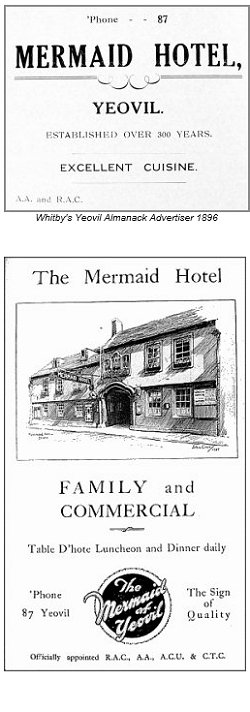 Frank was aged
26, married to
Edmonton-born
Hilda also 26
and they were
living in the
Mermaid Hotel
where Frank was
listed as the
hotel keeper.
Interestingly
the number of
living in hotel
staff had
increased and
now included a
cook, kitchen maid,
waitress, two
housemaids, two
chambermaids, a
boots and two
barmaids. Frank
died from
complications
manifesting from
a cold and an
internal
disorder on the
morning of
Christmas Eve
1892, aged just
27. Hilda took
over the license
and is listed as
late as 1895 in
Kelly's
Directory but I
lost her in the
records after
that.
Frank was aged
26, married to
Edmonton-born
Hilda also 26
and they were
living in the
Mermaid Hotel
where Frank was
listed as the
hotel keeper.
Interestingly
the number of
living in hotel
staff had
increased and
now included a
cook, kitchen maid,
waitress, two
housemaids, two
chambermaids, a
boots and two
barmaids. Frank
died from
complications
manifesting from
a cold and an
internal
disorder on the
morning of
Christmas Eve
1892, aged just
27. Hilda took
over the license
and is listed as
late as 1895 in
Kelly's
Directory but I
lost her in the
records after
that.
I've virtually no information on the following licensee, John Reed, who was listed in Kelly's Directory of 1897. The most likely suspect is John Read, a coach builder born around 1863 in South Cadbury, living in Frederick Place with his family in 1901 - he is the only John Reed in Yeovil at the time, but if he was the Mermaid's licensee for a brief time would be just a guess.
There is more information on Charles Thomas Pitcher; he was born on 16 November 1855 on the Old Kent Road, London, the son of brewer Isaac Pitcher (1810-1862) and his wife, Mary, née Harvey (b1821). In fact I've given Charles Thomas Pitcher his own page on this website.
WG Adams was listed as the licensee in 1923 followed by a span of over ten years by AJ Croft.
Sketch Plans of the Mermaid Hotel
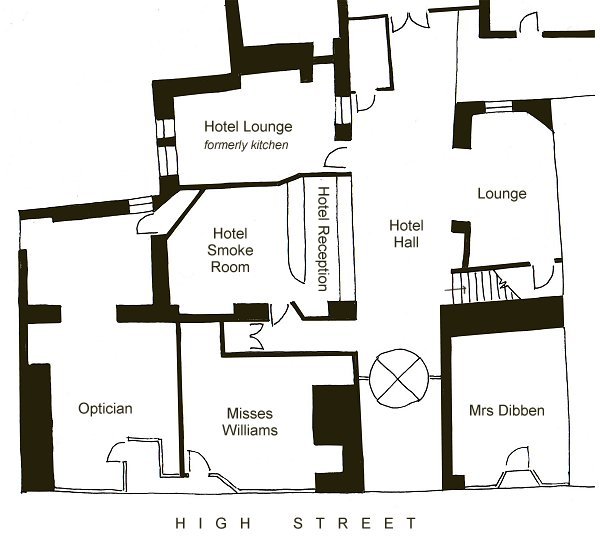
These are sketch plans based on originals held at the Heritage Centre, Taunton. The original plan above is dated 1938 and many people might be surprised to see that the facilities were for hotel guests only and not the general public.
The sketch plan below is based on an original dated 1957 at which time it was owned by Brutton, Mitchell Toms Ltd. The plan was submitted because the meeting room, towards the top of the plan, was being created from earlier 'vaults bars' and in the main hotel building a new servery was created in the lounge bar. It was probably around this time that the bars became more public-centred rather than being reserved exclusively for hotel guests. Nevertheless while new toilet facilities for both ladies and gents were created next to the new meeting room, there were still no ladies' toilet facilities in the main building.
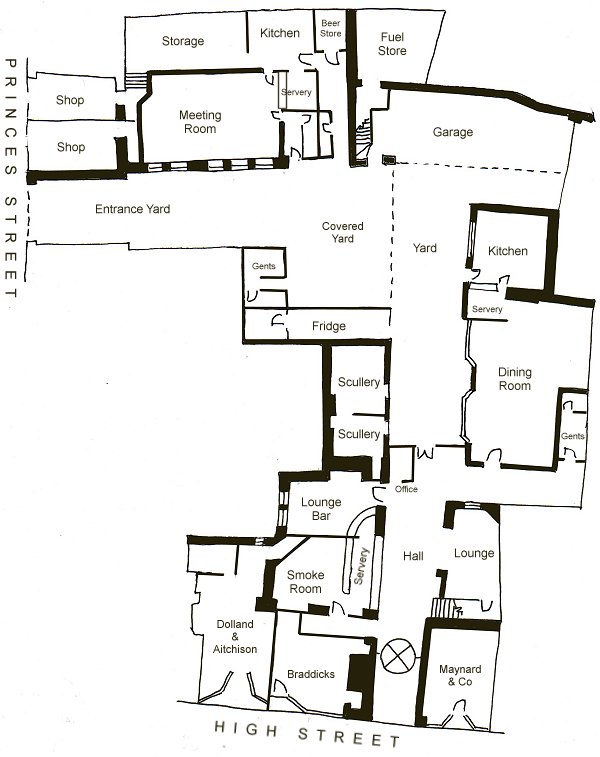
map

gallery


Advertisement in the Sherborne Mercury edition of 30 December 1799 for the Yeovil Ball to be held in the Mermaid and the 'last ball of the season' from the edition of 3 February 1800.
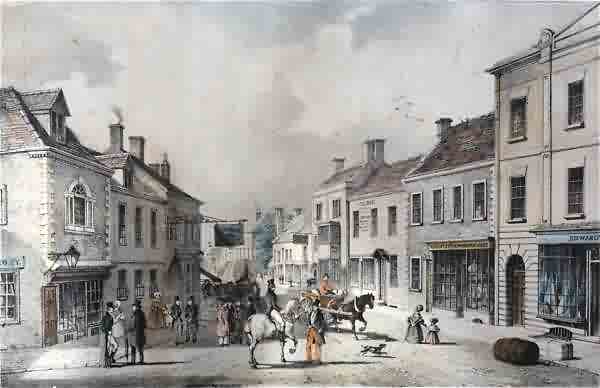
From my
collection
This lithograph looks down High Street from its junction with Hendford / Princes Street. On the left the Mermaid with its familiar archway and large overhanging sign is clearly seen. On the opposite side of the road, just right of centre, the white three storey building with the two-storey projecting bay is the Kings Head Inn. It is likely that the two storey building next to the Kings Head Inn is the building that held the former George Inn.
This hand-tinted stone lithograph was by Henry Burn (1807-1884) entitled 'Market Place - Yeovil'. There are not many known stone lithographs by Henry Burn because he left for Australia in 1852. It was published by William Porter and Henry Marsh Custard in January 1839 and printed by Charles Joseph Hullmandel (1789-1850) of London, where he maintained a lithographic establishment on Great Marlborough Street from about 1819 until his death.
For a more detailed account of the buildings in this 1839 lithograph, click here.
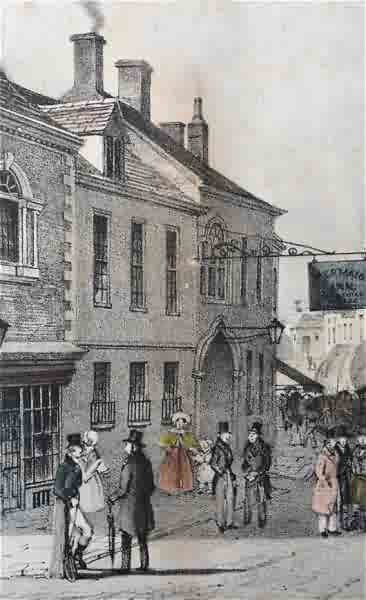
From my
collection
Enlarged from the previous lithograph, this is the earliest image I know of featuring the Mermaid.
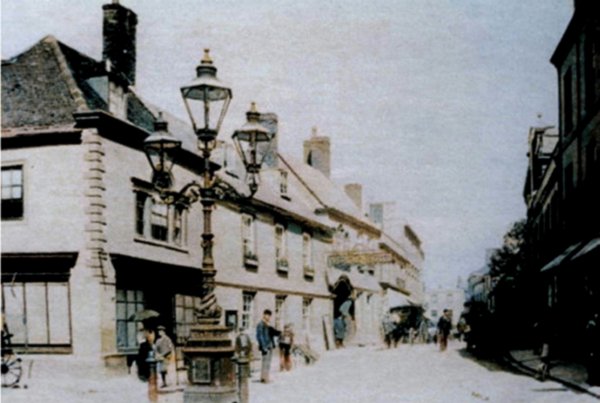
This colourised photograph
features in my
book 'Yeovil From Old Photographs'.
This is the earliest photograph I found of the Mermaid Hotel - it was taken between 1887 (when the 3-light Sugg lamp in the foreground was presented to the town to celebrate the Golden Jubilee of Queen Victoria) and 1897 (when the three storey Capital and Counties Bank seen in most subsequent photographs opened on the corner of High Street and Princes Street - replacing the building seen here at left). Of greatest interest, perhaps, is that this building preceding the bank, Henry White's home and shop, had an arched Venetian window at first floor similar to that above the Mermaid's entrance.
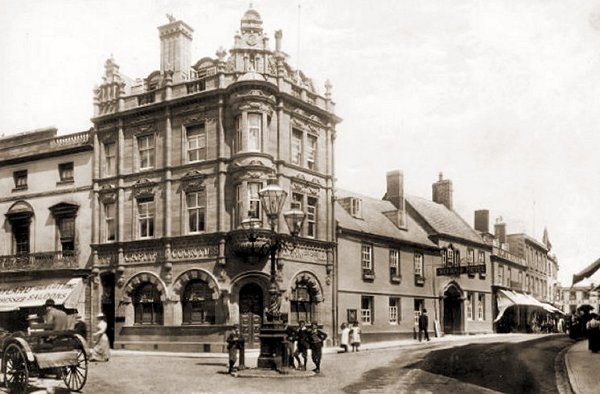
This photograph was taken around 1898 to show off the new building on the corner of Princes Street and High Street built for the Capital and Counties Bank and opened in 1897. It was later occupied by the National Provincial Bank, the national Westminster bank, then the Bristol and West Building Society and now the Britannia Building Society. The Mermaid, without today's ugly shops, stands alongside to the right.
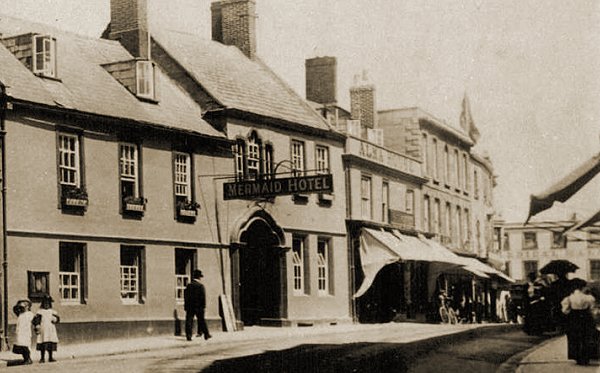
An enlargement of the previous postcard, showing the Mermaid and Alma House next door.
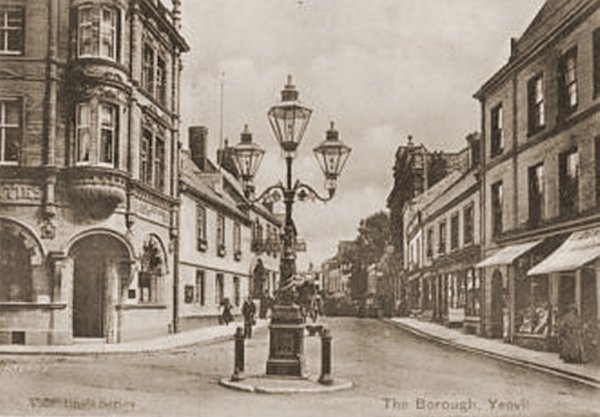
This sepia-toned postcard is dated 1904 and looks along High Street towards the Borough. The Mermaid Hotel is seen to the left of the large three-light Sugg gas lamp that was donated to the town by the Yeovil Gas and Coke Company in 1887 to celebrate Queen Victoria’s Golden Jubilee.
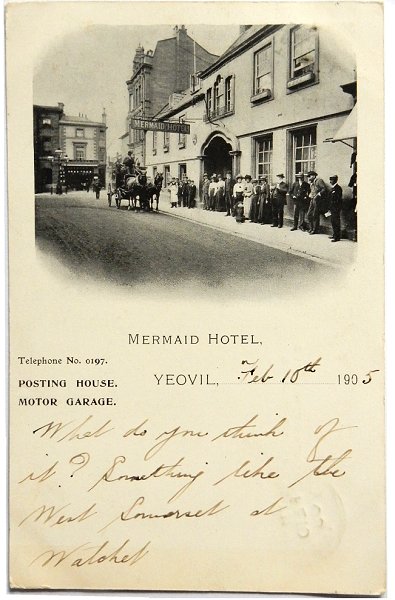
From my
collection
A postcard of 1905. The detail is enlarged below.

From my
collection
-
This colourised photograph
features in my
book 'Yeovil
From Old
Photographs'
This photograph is taken from the above postcard. Note the horse-drawn omnibus - the Mermaid had its own omnibus that ran to and from the railway stations as a courtesy to guests.

Courtesy of
Betty Barber
(née Bird)
By 1937 the Mermaid Hotel and the Three Choughs Hotel had combined their omnibus service to meet trains at each station. Because of its livery, this omnibus was known as the "Yellow Peril" - seen here in a colourised photograph of 1937.
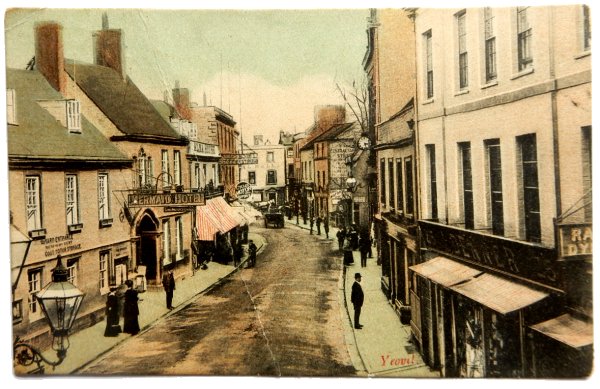
From my
collection.
This
image
features in my
book 'Yeovil
- The Postcard
Collection'.
A hand-coloured postcard of High Street, this one postmarked 1907.
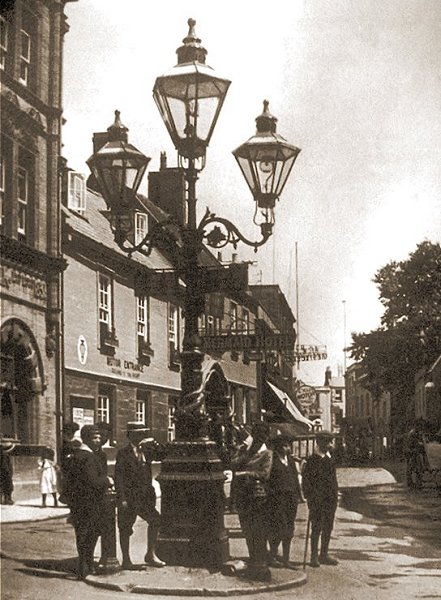
This photograph looks down High Street towards the Borough and, I think, dates to around 1910. A group of fashionably-attired young lads gather around the Sugg lamp at the junction of Hendford and High Street. A far cry from the previous photograph with its horse-drawn omnibus, the Mermaid now has a notice painted on its wall saying 'Motor Entrance around the corner'.
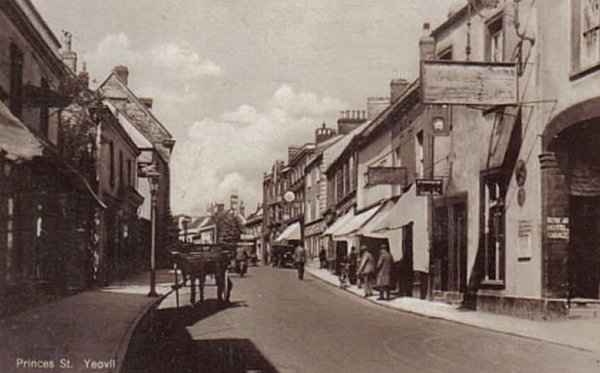
This postcard of Princes Street dates to about 1925 and shown at extreme right is the rear entrance to the Mermaid Hotel which was also the entrance to the Hotel guests' garage. The shop next door - now re-fronted on the ground floor and currently occupied by Chant's estate agent - has a sign above the door reading 'Scotch Ale' suggesting that this was the Mermaid's off-sales at this time.

The garage entrance to the Mermaid Hotel, mentioned in the previous photograph, is seen here at right in this photograph of the 1930's looking along Princes Street. Note the wonderfully ornate bracket from which the Mermaid's sign is suspended. The buildings both sides of the street remain unaltered today apart from modern shop fronts.

From my
collection
I'm not sure when the photograph of this colourised postcard was taken but it must have been during the 1920's or 1930's judging by the AA and RAC signs (although, of course, the RAC was founded in 1897 and the AA in 1905). However it does show up particularly well the fine entrance arch and the Venetian window over - frequently overlooked as today's world rushes by. Note too the absence of shops on the ground floor either side of the arched entrance - I doubt that many Yeovilians can remember it looking like this!
Originally, of course, the Mermaid was only that part from the arch and to the right; that part now 1a and 1b High Street to the left of the arch was originally built as a single town house in the late eighteenth century.
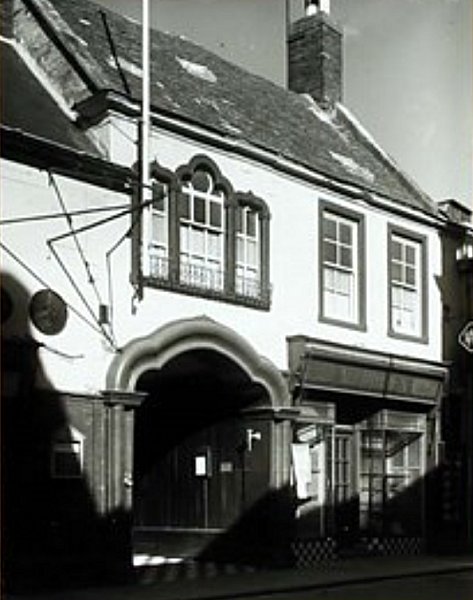
By 1942, the date of this photograph, a shop had been inserted into the Mermaid's structure - the first of what would become three shops.
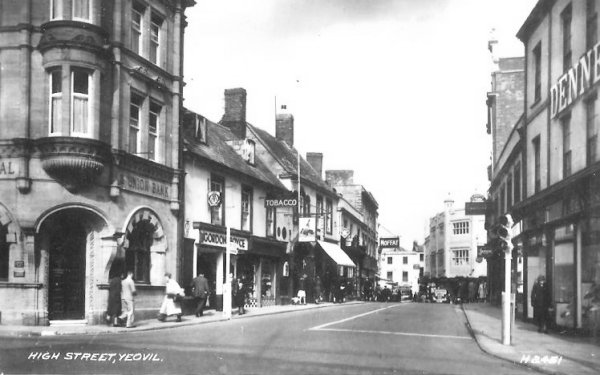
This postcard of High Street dates to about 1955 and shows, for the first time, the shops installed on the ground floor elevation facing High Street.
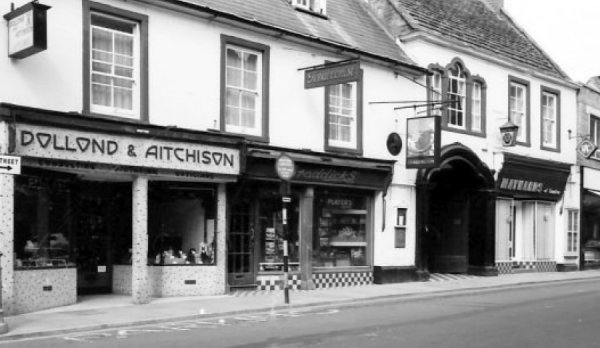
A far more familiar view taken in the 1960's with the ground floor shops now present, although I must admit that I can't remember the Mermaid being painted white. At left is opticians Dollond & Aitchison next to Braddick's tobacconists. To the right of the Mermaid arch it looks like Maynard's sweet shop has closed down - I seem to remember it moved to Princes Street. The shop then became 'The Little Shop' for a brief spell.
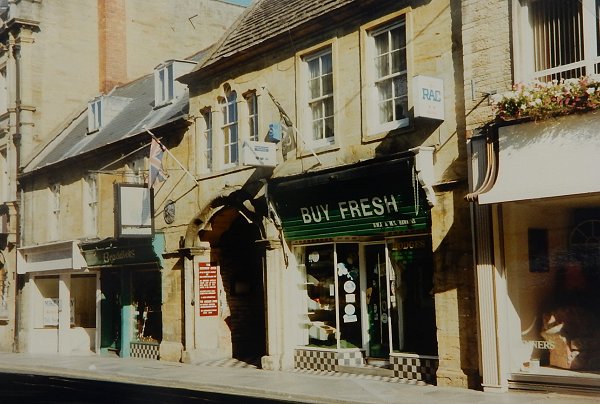
The Mermaid photographed in the 1990s. Dollond & Aitchison has gone, Braddick's remains and Buy Fresh greengrocery has moved in to replace Maynard's sweet shop and The Little Shop. Buy Fresh was, in turn, replaced by hairdressers Hair@K&Gs by 2008 (and, briefly in 2014 Signature Hair). At extreme right Denner's has moved into what had been the store begun by Ince Gamis in the 1840s.
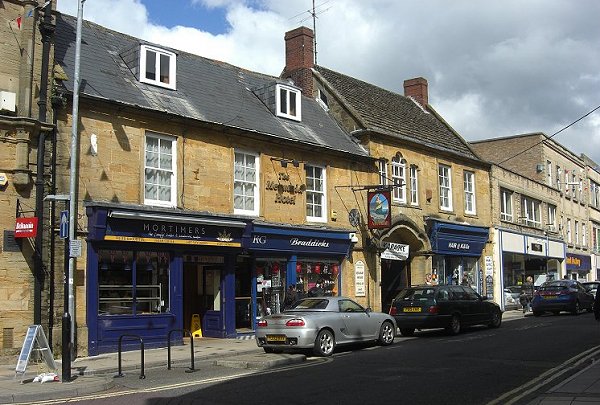
I think I prefer the natural stone look of today. Sadly though, with the three shops at street level, this fine old inn does seem to merge with the general street scene and has completely lost the look of the fine building in the first photograph. Photographed in 2012. Mortimer's bakery has replace Dollond & Aitchison while Braddick's tobacconist is still going strong - I wonder when it started?

Taken from the above photograph, this shows the extent of what originally would have been the Mermaid Inn - a surprise to most of us.
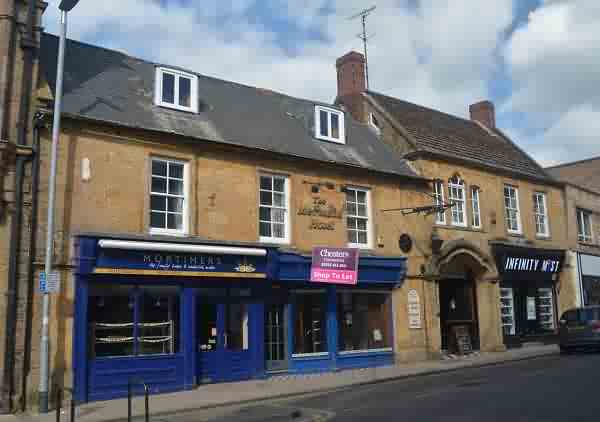
This photograph
features in my
book "Yeovil
In 50 Buildings"
.... and photographed in 2017 after Braddick's had relocated to Westminster Street.
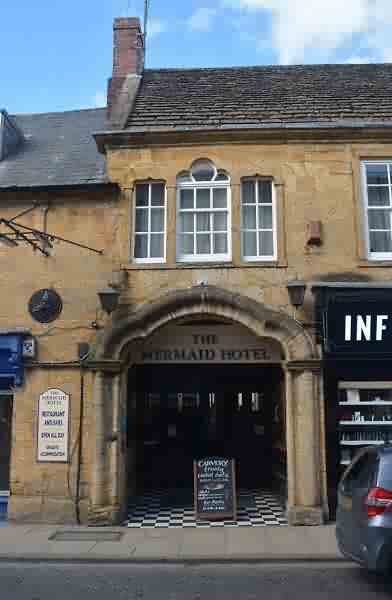
This photograph
features in my
book "Yeovil
In 50 Buildings"
Detailing of the famous ogee-headed archway and the lovely Venetian window above. Photographed in 2017.
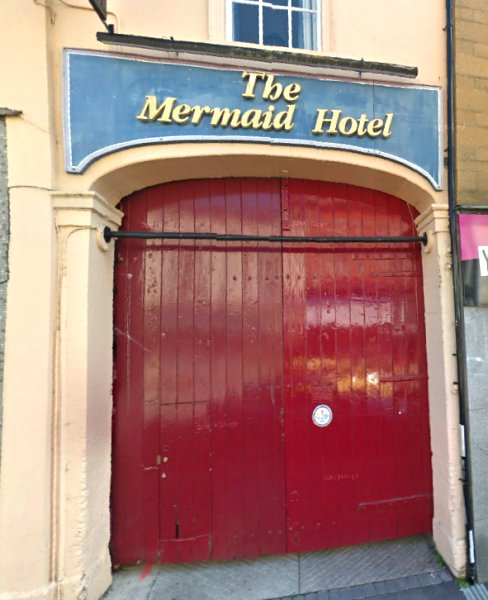
The rear entrance in Princes Street - once the entrance for horses and later the entrance to parking for hotel guests with those new-fangled petrol-driven automobiles.
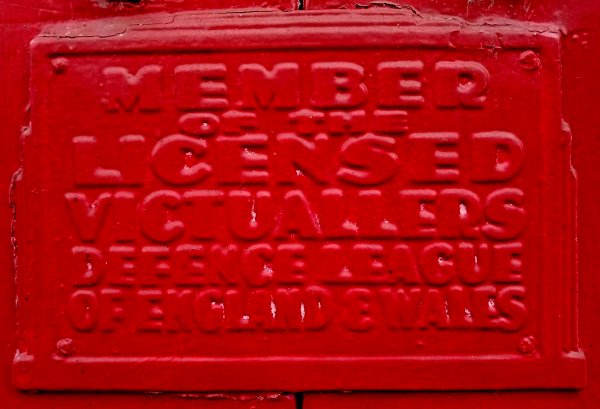
Courtesy of
Ian Phillips
This plaque is affixed to the Mermaid's rear entrance door of the previous photograph, just above the small whit round sign. The Licensed Victuallers Defence League of England and Wales was formed in 1872 to lobby for protection and reform of their trade. This was at a time when the temperance movement was gaining support - as well as three temperance hotels, Yeovil also had several temperance societies as well as other temperance establishments such as the Rising Star (also known as the British Workman's Public House) and, between 1894 and 1919, the 'Come and Welcome Coffee Tavern' at 5 Wine Street.

Courtesy of
Catrina
Southword
This tunnel, seen from the Mermaid's cellar, runs under High Street towards what was the Argos outlet. It is blocked further in and presumably ran to either the cellar of the Fleur de Lys (which was opposite the Mermaid) or the King's Head Inn, just two buildings closer to the Borough from the Fleur de Lys.
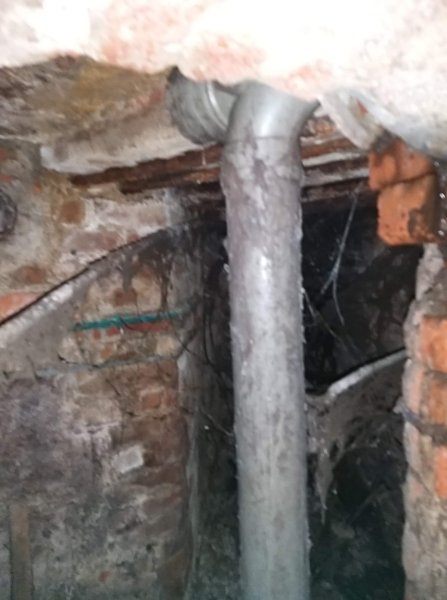
Courtesy of
Catrina
Southword
This second tunnel, also seen from the Mermaid's cellar, runs under High Street towards what is now the Westminster Bank. Again, it is blocked further along and presumably originally ran to the old Angel Inn in Hendford, that faced High Street - see next photos.
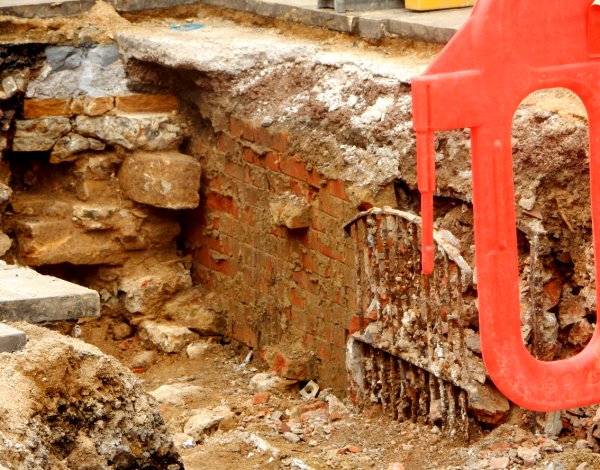
A close-up of the southern (Hendford) end of the trench outside the Westminster Bank during the excavations of April 2023 showing, at the left, a substantial stone wall with what appear to be a course of thin medieval red bricks - the external cellar wall of the old Angel Inn. At the centre is a wall of relatively modern red bricks, which I believe is part of the cellar wall of Stuckey's Bank.
To the right is the metal gate. This is pure conjecture on my part, but could this be the other end of the tunnel (see above) from the cellar of the Mermaid Hotel to the Angel Inn? Photographed in April 2023.

A direct view of the metal gate guarding the now-blocked access to the cellar of the Angel Inn. Photographed in April 2023.
owners / tenants / licensees
c1660 - Joseph
Clarke (from
trade token -
see above)
pre-1677 –
Bullock (see
Documentation
below)
1738 – Edward
Mines (ditto)
1759 – George
Gast (died
c1769 - see
newspaper
clipping shown
above)
1769 – Samuel
Lloyd (Newspaper
clipping shown
above)
1777 – William
Simpson
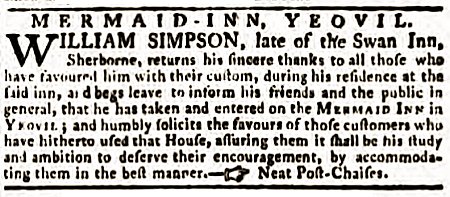
Bath Chronicle &
Weekly Gazette -
8 May 1777
1785 – Licensee
unknown
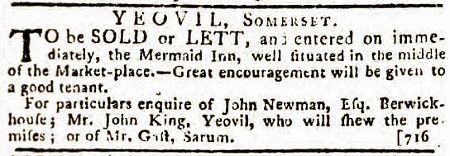
Salisbury &
Winchester
Journal - 23
June 1788
1793 – Susannah
Weldon –
Victualler
(Universal
British
Directory)
1810 – Mr
Wilkins
1822 – Hannah
Wilkins (Pigot’s
1822 Directory)
listed as
Mermaid and
Posting House
1824 – Hannah
Wilkins (Pigot's
1824 Directory -
see
Documentation
below)
1827 – Richard
Treherne,
innkeeper (1827
Jury List)
1828 – Hannah
Wilkins, owner -
Rd. Treharne,
occupier (Land
Tax Returns)
1830 – Richard
Trehern (Pigot’s
1830 Directory)
listed as
Mermaid Inn
(Commercial &
Posting)
1831 – Hannah
Wilkins, owner -
Richard Treharne,
occupier (Land
Tax Returns)
1832 – Hannah
Wilkins, owner -
Richd. Treherne,
occupier (Land
Tax Returns)
1839 – Frederick
Watts (Robson’s
1839 Directory)
listed as
Mermaid Hotel
1840 – Fred
Watts (Somerset
Gazette 1840
Directory)
1841 – Sarah
Watts – Inn
Keeper (1841
census) not
named but in
High Street
1842 – Frederick
Watts (Pigot’s
1842-4
Directory)
listed as
Mermaid Inn
1846 – Frederick
Watts (1846 Poll
Book) listed as
Mermaid Inn
1846 – William
Wilkins, owner -
Frederick Watts,
occupier (Tithe
Apportionment)
1851 – Frederick
Watts - Hotel
Keeper (1851
census) – listed
as Mermaid Inn
1852 – Frederick
Watts - Inn
Keeper (Slater’s
1852 Directory)
– listed as the
Mermaid Inn
1856 – Frederick
Watts (see
Documentation
below)
1859 – Frederick
Watts (Harrison,
Harrod & Co 1859
Directory)
1861 – John
Corrie (Kelly’s
1861 Directory)
1861 – John
Corrie – Hotel
Keeper (1861
census) listed
as Mermaid Hotel
1861 – John
Corrie – Hotel
Keeper (1861
census) listed
as Mermaid Hotel
1864 – John
Corrie – Fined
for having short
measures (Petty
Sessions,
August)
1872 – John
Corrie (Kelly's
1872 Directory -
Hotels & Inns)
1875 – John
Corrie (Kelly's
1871 Directory -
Hotels & Inns)
1881 – John
Corrie – Hotel
Proprietor (1881
census) listed
as Mermaid Hotel
1882 – John
Corrie (Kelly’s
1882 Directory)
1886 – John
Corrie - sale of
Mermaid Hotel (Western
Gazette, 29
October 1886)
1889 – Frank
Hulbert (Kelly’s
1889 Directory)
listed as
Mermaid Hotel
1891 – Frank
Hulbert – Hotel
Keeper (1891
census) listed
as Mermaid Hotel
1895 – Mrs Hilda
Hulbert
(Kelly’s 1895
Directory)
listed as
Mermaid Family &
Commercial
Hotel &
Posting House &
Wine & Spirit
Merchant
1897 – John Reed
(Kelly’s 1897
Directory)
listed as
Mermaid Hotel
1901 – Charles
Pitcher – Hotel
Keeper (1901
census) listed
as Mermaid Hotel
1911 – Charles
Pitcher – Hotel
Keeper (1911
census) with
eleven staff
living in
1914 – Charles
Pitcher (Kelly’s
1914 Directory)
listed as
Mermaid Hotel
1923 – WG Adams
(Kelly’s 1923
Directory)
listed as
Mermaid Family &
Commercial Hotel
& Posting
House
1935 – Mr & Mrs
AJ Croft –
Proprietors
(Kelly’s 1935
Directory)
1936 – AJ Croft
(1936 Yeovil
Directory)
listed as
Mermaid Hotel
1938 – AJ Croft
(1938 Yeovil
Directory)
listed as
Mermaid Hotel
1939 – AJ Croft
- Proprietor
(Kelly’s 1939
Directory)
listed as
Mermaid Family
and
Commercial
Hotel
1947 – AJ Croft
(1947 Yeovil
Directory)
listed as
Mermaid Hotel
1949 – Licensee
not named
(Kelly’s 1949
Directory)
listed as
Mermaid Hotel
1951 – Licensee
not named (1951
Yeovil
Directory)
listed as
Mermaid Hotel
1957 – Licensee
not named (1957
Yeovil
Directory)
listed as
Mermaid Hotel
1960 – Licensee
not named (1960
Yeovil
Directory)
listed as
Mermaid Hotel
1965 – Licensee
not named (1965
Yeovil
Directory)
listed as
Mermaid Hotel
1969 – Licensee
not named
(Kelly’s 1969
Directory)
listed as
Mermaid Hotel
1972 – Licensee
not named
(Kelly’s 1972
Directory)
listed as
Mermaid Hotel
1973 – Licensee
not named
(Kelly’s 1973
Directory)
listed as
Mermaid Hotel
1974 – Licensee
not named (1974
Yeovil
Directory)
listed as
Mermaid Hotel
1987 – Licensee
not named
(Denton’s 1987
Directory)
listed as
Mermaid Hotel
1990 – Ian
Butters, Relief
Manager - Bass
South West Ltd,
owners
1993 – JC & RH
Palmer of
Bridport,
owners, John
McClimonds,
tenant
Documentation
|
1629 |
Yeovil -
'The
Miremaide'
in the
High
Street.
(Somerset
& Dorset
Notes &
Queries
X.301 -
Old Inn
Signs in
Somerset
& Dorset
- PRO
and
Somerset
House) |
|
1677 |
The Mermaid 'that was Bullock's in High Street'. |
|
1738 |
To be Let, and Enter'd upon at Lady Day next, or at any time before if desired, The Mare-Maid Inn in Yeovil in Somersetshire, well situated in the Market-Place, with good Stables, Brewhouse, and all Conveniences fit for an Inn; being now in the possession of Edward Mines, Glover. Also about 40 Acres of good Meadow Ground fit for Grasing, or a Dairy situate near Yeovil, well water'd. Likewise several Houses to be sold in Yeovil. Any person having Occasion of any of these, may recieve good Encouragement by applying to the Proprietor, Mr Edward Mines, Glover, in Yeovil. (The Sherborne Mercury. 24 January 1738, Advertisement, p4) |
|
1785 |
Chief rents due to Edward Phelips, Esq. - Mr Gast for Mermaid Inn. 16s. (Mayo documents). |
|
1790 |
Whitmarsh's post-coach set out from the Mermaid Inn every Monday, Wednesday and Friday at 10 o'clock in the morning, and arrives at the Saracen's Head Inn, Friday Street, London, the following day; and returns to Yeovil every Tuesday, Thursday and Saturday, about one o'clock in the afternoon, in its way to Taunton. The Exeter coach arrives at the Mermaid Inn about 12 o'clock at noon in its way to London; and gets to the Bell & Crown, Holborn, the following day; and arrives from London, about one in the afternoon. every Tuesday, Thursday and Saturday, in its way to Exeter. (Universal British Directory - Coaches - 1790). |
|
1793 |
Susannah Weldon, Victualler (Mermaid) - (Universal British Directory 1793). |
|
1797 |
"We were very lucky in our weather except the first Evening when it rained almost all the way from Ansford Inn to Yeovil, where we slept at the Mermaid, a most horrid Inn, the Angell is shut up and the next day we found to our mutual astonishment that the Inn at Crewkerne was as good as that was bad, so, had we persued our original plan, we should have fared much better." (Somerset & Dorset Notes & Queries XXXII.677: Letter from TS Horner, to his father at Mells, August 1797. Extract). |
|
1810 |
There will be a Ball at the Mermaid Inn in Yeovil on Monday the 7th day of January 1811. Tickets to be had of Mr Wilkins. (Western Flying Post, 12 November. Advertisement, p4). |
|
1817 |
The Yeovil Philharmonic Society gave its first concert before an audience of 150 at the Mermaid Hotel. (Western Flying Post, 2 May 1817). |
|
1824 |
Mermaid (and Posting House), Borough, Hannah Wilkins - Coaches - Mermaid, Royal Auxillary Mail - London, every day at one. To Bridport and Weymouth, Tuesdays, Thursdays and Saturdays, afternoons at two. (Pigot's 1824 Directory - Inns & Hotels). |
|
1828 |
Hannah Wilkins, proprietor; Rd. Treherne, occupier (Land Tax Returns) |
|
1830 |
Coaches - to London... The Traveller calls at the Choughs and Mermaid Inns, every afternoon at half-past one, goes through Sherborne, Shaftesbury, Salisbury, etc. To Bristol... the Royal Dorset from Weymouth calls at the Choughs Inn every Monday, Wednesday and Friday at a quarter before twelve - goes through Ilchester, Glastonbury, Wells, etc. To Exeter... the Traveller calls at the Mermaid and Choughs Inns every morning at nine, goes through Crewkerne, Chard, Honiton, etc. To Weymouth... the Royal Dorset, from Bristol, calls at the Choughs Inn every Tuesday, Thursday and Saturday at a quarter before two, goes through Dorchester. (Pigot's 1830 Directory - Inns) |
|
1831 |
Hannah Wilkins, proprietor; Rd. Treherne, occupier (Land Tax Returns) |
|
1831 |
Reform Riots - Saturday 22 October 1831 - Mob said to have threatened to sack the town. Yeomanry captured two rioters, brought before magistrates sitting at the Mermaid Inn. Insurgents attacked the inn with a view of rescuing the captives; windows broken. Yeomanry dispersed the crowd, having been ordered to 'fire four in the air, and two at the rioters'. One rioter injured. (Notes of Leslie Brooke) |
|
1846 |
18A Mermaid Garden - OA or 20p - owner William Wilkins, occupier Frederick Watts. (Note - the 1842 Tithe Map shows 18 as inn in High Street and 18A 'The Garden' off Church Street.) (Tithe Apportionment) |
|
1846 |
4 November 1846 - Ordered that the owners of the Outhouse adjoining the Back Gateway to the Mermaid Inn be paid £10 for setting back the front wall of it about 15 inches in a line with the adjoining Buildings the wall being rebuilt at least to the height of 6 feet. (Town Commissioners Minutes) |
|
1850 |
Inland Revenue Office: Mermaid Inn; Superviser, Richard C Amey (Innkeeper Frederick Watts) - (Hunt & Co 1850 Directory) |
|
1852-3 |
Excise Office, at the Mermaid Hotel. John Edwards, supervisor (Innkeeper Frederick Watts) - (Slater's 1852-3 Directory) |
|
1852-3 |
Coaches
- To
Dorchester,
the
Royal
Mail
from the
Three
Choughs
Hotel
every
morning
at
eight,
and
evening
at six.
To
Taunton,
the
Royal
Mail
from the
Three
Choughs,
every
morning
at nine
and from
the
Mermaid,
at five
in the
evening. |
|
1854 |
"... the 'Mermaid' was a posting house and for gatherings of gentlemen farmers. I saw the Earl of Cardington arrive at Hendford Station on his coming home from the Balaclava Charge of his Light Brigade (1854). He was on his way to Crichel, near Wimborne, to his sister, Lady Gerard Sturt. At Hendford the Yeovil boys took the horses out of his carriage and dragged it with ropes to the Mermaid Hotel. The General thanked the people in two or three words from the upper window near the left side of the archway entrance, but he seemed to me to look much worried and sad. (Newspaper Cutting (Unspecified), Letter by WC Clothier, 22 April 1922. (aged 9 in 1853)). |
|
1856 |
p.46
- The
two
principal
hotels
are the
Choughs
and the
Mermaid;
and
between
these
two
establishments
and the
railway,
omnibuses
run to
and fro,
at the
going
out and
the
coming
in of
each
train. |
|
1888 |
2 March 1888 - Mr T Brown proposed, Mr Meade seconded, That the charge for attending the Fire at Mermaid Hotel be as follows: 8 men @ 7/6. £3; 6 do. all night 10s.6d. - £3.3s.; Police 2s.6d.; Helpers £6 5s.; Damage to uniforms £2 10s.; Engineer £1 10s. - £16 10s. 6d. - Carried unanimously. (Fire Brigade Minutes, 2 March 1888) |
|
1911 |
Carriers - Chant on Saturdays for Stoke, Purchase on Saturdays for Tintinhull. Omnibuses from the Three Choughs and Mermaid Hotels meet every train. (Whitby's 1911 Yeovil Almanack Advertiser) |
|
1948 |
Grade II - Mermaid Hotel - There are two parts to the High Street frontage, the older probably late 17th or early 18th century. This is two-storey three-wondow pointed stone. Steep roof of stone slates (actually tiles). Moulded stone eaves, cornice, with concealed gutter. First floor has three sash windows, one of these being three light with a trefoil head to the central light and ogee curves to the heads of the side lights. Windows have flat painted stone architraves and window-box rails. Ground floor has wide arched entrance with very heavy moulded stone bilection mould and moulded imposts. The arch itself is trefoil in shape. A shop-front has been inserted. Remainder of front is lower two-storey three window, probably late 18th or early 19th century. Sash windows with flat painted stone architraves. Slate roof, dormers. Moulded stone eaves, cornice, with later gutter. (Ministry of Town & Country Planning - Yeovil Municipal Borough - Provisional List of Buildings of Architectural or Historic Interest - July 1948 - High Street, north side). |
|
1965 |
High
Street -
Mermaid
- Is the
arch Art
Nouveau
or much
older? A
pleasant
stone
facade
over.
Already
Grade
II.
(Brief
Report
on
Buildings
by
Rodney D
Goodall,
Frome) |

